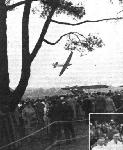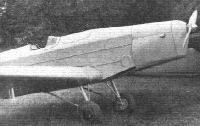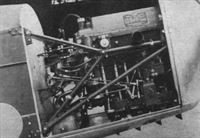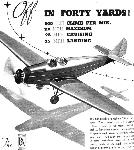
Описание
Страна : Великобритания
Год : 1933
Двухместный легкий учебно-тренировочный самолет
Варианты
- Daimler - L 20 - 1924 - Германия
- Klemm - L.25 - L.28 Swallow - 1927 - Германия
- British Klemm - L.25 Swallow - 1933 - Великобритания
British Aircraft (British Klemm) L.25 Swallow
В середине 1920-х - начале 1930-х годах большим успехом среди заказчиков пользовались учебно-тренировочные самолеты немецкой компании "Klemm". Одной из наиболее удачных моделей, созданных конструкторами данной компании, стал L.25, совершивший первый полет в 1927 году и отличавшийся достаточно высокой надежностью и хорошими летными качествами, необходимыми для машин его класса. Самолет был спроектирован на базе более раннего варианта L.20, в 1933 году британцы приобрели 27 таких машин, и примерно в то же время в Великобритании была образована компания "British Klemm Aeroplane Со." (Хэнворт, графство Мидлсекс), в задачу которой входила постройка этих машин уже на территории метрополии.
Прототип британского варианта L.25 совершил первый полет в ноябре 1933 года, он отличался от базового самолета тем, что некоторые части его конструкции были усилены в соответствии с требованиями норм летной годности Великобритании. Самолет представлял собой свободнонесущий низкоплан деревянной конструкции с полотняной обшивкой рулевых поверхностей и имел складывающиеся крылья (это облегчало его базирование и хранение), две расположенные по схеме тандем открытые кабины пилотов, неубирающееся шасси с хвостовым костылем и хорошо зарекомендовавший себя двигатель малой тяги.
Первые серийные машины получили обозначение British Klemm L.25C1A Swallow, причем прототип и пять первых серийных самолетов были оснащены звездообразным двигателем British Salmson A.D.9 мощностью 75 л. е., а остальные - за исключением одной машины - получили звездообразный двигатель Pobjoy Cataract II мощностью 85 л. с. После того как предприятие выпустило 28 самолетов в конструкцию L.25 Swallow внесли изменения: крыло, стабилизатор, киль и руль направления приобрели угловатые очертания, что по расчетам специалистов компании, должно было ускорить процесс постройки самолета. В этих же целях верхняя часть фюзеляжа была сделана более "грубой", потеряв свою гладкую вылизанную форму.
Учитывая, что в то же самое время компания изменила свое название на "British Aircraft Manufacturing Со.", модернизированный самолет получил обозначение British Aircraft Swallow 2. Было построено более 10 самолетов, оснащенных одним двигателем Cataract III или двигателем Blackburn Cirrus Minor 1 мощностью по 90 л. с. каждый. Часть из этих машин использовалась и в годы Второй мировой войны в качестве учебно-тренировочных в составе добровольческого Учебного авиакорпуса или в качестве "неофициальных" персональных самолетов командиров авиабаз британских ВВС. По имеющимся данным, в 1940 году британские ВВС реквизировали четыре самолета L.25, из которых три разобрали, превратив в учебные планеры, а один использовали как учебно-тренировочный самолет.
ТАКТИКО-ТЕХНИЧЕСКИЕ ХАРАКТЕРИСТИКИ
British Klemm L.25C 1A Swallow
Тип: двухместный легкий учебно-тренировочный самолет
Силовая установка: один звездообразный двигатель Pobjoy Cataract II мощностью 85 л. с. (64 кВт)
Характеристики: максимальная скорость на оптимальной высоте 167 км/час; крейсерская скорость на оптимальной высоте 145 км/час; начальная скороподъемность 244 м/мин; практический потолок 5180 м; дальность 676 км
Масса: пустого 435 кг; максимальная взлетная 680 кг
Размеры: размах крыла 13,00 м; длина 8,00 м; высота 2,13 м; площадь крыла 20,00 м2
Описание:
- British Aircraft (British Klemm) L.25 Swallow
- Flight, March 1934
A BRITISH KLEMM - Flight, April 1936
MODERN LIGHT AIRCRAFT REVIEWED - Flight, March 1938
British light aircraft
Фотографии
-
Aeroplane Monthly 1990-01 / B.A. Swallow 2 G-AEVZ /Preservation Profile/
Регистрационный номер: G-AEVZ [6] GORDON BAIN'S stunning photograph features Mark Newman's 1937 BA Swallow G-AEVZ, photographed over the Solent on October 29, 1983 with previous owner Terry Warren at the controls.
-
Flight 1935-05 / Flight
Регистрационный номер: G-ADDB [11] Although the passenger in this view is actually wearing goggles the screens of the new "Swallow" permit comfortable flying without them. Flt. Lt. J. B. Wilson, the makers' chief test pilot, is piloting the machine.
-
Мировая Авиация 79
Регистрационный номер: G-ADDB [11] Изображенный на снимке самолет, G-ADDB, строился как Swallow, но в мае 1935 года появился уже в модернизированном виде, как прототип модификации Swallow 2. Одна из основных задач модернизации заключалась в сокращении сроков постройки машины.
-
Flight 1936-04 / Flight
Регистрационный номер: G-ADDB [11] The Swallow has an enviable reputation for safe and easy handling.
-
Flight 1937-11 / Flight
Регистрационный номер: G-ADDB [11] British Aircraft type, the Pobjoy-engined Swallow. The Swallow is, of course, available with the Cirrus Minor engine.
-
Flight 1937-03 / Flight
Регистрационный номер: G-ADDB [11] Best known of the British Aircraft range, the Swallow has made an enviable reputation for itself both as a trainer and a private owner's machine. It may be fitted either with a Pobjoy or a Cirrus engine.
-
Aeroplane Monthly 1990-06 / J.Meadows - Flying for fun (1)
Регистрационный номер: G-ADDB [11] In its new form the "Swallow" has attractive, if relatively austere, lines, while retaining the distinctive appearance of the type.
The B.A.Swallow, on which the author learnt to fly, was available with Salmson or Pobjoy radial engines - the Swallow 2 was supplied with the inline Blackburn Cirrus. -
Flight 1935-12 / Flight
Регистрационный номер: G-ADDB [11] Open and closed. The one of two B.A. machines is the Swallow.
-
Flight 1935-05 / Flight
Регистрационный номер: G-ADDB [11] Not a new type of Autogiro, but an amusing juxtaposition with the new B.A. "Swallow"; incidentally, the "Swallow" displayed almost Autogiro-like slow-flying capabilities.
-
Air-Britain Archive 1986-01
Регистрационный номер: G-ADLD D-ENGA together with two-seater D-EJIK flown by Troll and Poulet being led in open vic formation by B.A.Swallow G-ADLD, pilot Monteith. Ironically perhaps, the Swallow was destroyed by enemy action at Lympne in 1940.
Другие самолёты на фотографии: Gerner G.II - Германия - 1930
-
Aeroplane Monthly 1998-10 / Skywriters
Регистрационный номер: G-ADPS BA Swallow G-ADPS at Old Warden on July 19, 1978.
-
Air-Britain Archive 1983-02
Регистрационный номер: G-AEHL, G-AELJ, G-AFGC On the subject of G-AEHL, we have received this photo taken at Witney about 1939. Behind it the other two Swallows are G-AFGC and G-AELJ, with Moth G-AAKO at the end of the line. Of the four only G-AELJ was not impressed.
Другие самолёты на фотографии: De Havilland Gipsy Moth / Moth X - Великобритания - 1928
-
Aeroplane Monthly 1981-03 / Personal album
Регистрационный номер: G-AELG In complete contrast Lt Cmdr Paid Godfrey makes a leisurely exit in his B.A. Swallow G-AELG.
-
Aeroplane Monthly 1979-07 / Hooton Park /Gone but not forgotten/ (3)
Регистрационный номер: G-AEMS B.A. Swallow G-AEMS, owned by the Merseyside Aero & Sports Ltd, crashed at Bromborough, Cheshire, on May 1, 1938.
-
Aeroplane Monthly 1985-07 / B.A. Swallow 2 G-AFCL /Preservation Profile/
Регистрационный номер: G-AFCL [7] Photograph of the Swallow taken during the Sixties.
-
Air-Britain Archive 1980-03
Регистрационный номер: G-AFCL [7] British Aircraft Swallow G-AFCL demonstrating its slow flying qualities, large wing area and the lengthy exhausts of the Pobjoy Niagara!
-
Aeroplane Monthly 1978-09
Регистрационный номер: G-AFCL [7] Hugh Field takes A. M. Dawson’s Old Warden-based B.A. Swallow 2 for an airing on May 28, 1978.
-
Aeroplane Monthly 1985-07 / B.A. Swallow 2 G-AFCL /Preservation Profile/
Регистрационный номер: G-AFCL [7] -
Aeroplane Monthly 1985-07 / B.A. Swallow 2 G-AFCL /Preservation Profile/
Регистрационный номер: G-AFCL [7] Photograph of the Swallow taken during the Sixties.
-
Aeroplane Monthly 1985-07 / B.A. Swallow 2 G-AFCL /Preservation Profile/
Регистрационный номер: G-AFCL [7] Swallow G-AFCL photograph during the early Fifties, presumably dur participation in an air race.
-
Air-Britain Archive 1984-03
Регистрационный номер: G-AFCL [7] BA Swallow G-AFCL is still current but when photographed at Tollerton on 29.9.62 it sported a distinctly crushed style of fin and rudder.
-
Aeroplane Monthly 1985-01
Регистрационный номер: G-AFGD [3], BK897 [3] B.A. Swallow II G-AFGD, owned by A.T.Williams and based at Shobdon.
-
Aeroplane Monthly 1988-08 / B.A. Swallow 2 G-AFGE /Preservation Profile/
Регистрационный номер: G-AFGE [9], BK894 [9] The photograph of BA Swallow G-AFGE was almost certainly taken pre-war.
-
Aeroplane Monthly 1988-08 / B.A. Swallow 2 G-AFGE /Preservation Profile/
Регистрационный номер: G-AFGE [9], BK894 [9] The photograph of BA Swallow G-AFGE was almost certainly taken pre-war.
-
Air-Britain Archive 1984-04
Регистрационный номер: G-AFGE [9], BK894 [9] As BK894, G-AFGE followed the same route but was restored by Mr.Arden on 21.5.46 and has had a varying degree of activity ever since. Stuart MacConnacher's photo shows it at Old Warden on 28.8.66, in pre-lilac days!
-
Aeroplane Monthly 1988-08 / B.A. Swallow 2 G-AFGE /Preservation Profile/
Регистрационный номер: G-AFGE [9], BK894 [9] The picture was taken at Old Warden in July 1969, shortly after ’GE was entrusted to the Shuttleworth Collection for a short period. The colour scheme at this time was maroon and cream and the name Aeolus (meaning God of Winds) was scripted on the port side. G-AFGE is powered by a seven-cylinder 80 h.p. Pobjoy Cataract III radial engine.
-
Aeroplane Monthly 1974-01 / ??? - Aeolus
Регистрационный номер: G-AFGE [9], BK894 [9] -
Aeroplane Monthly 1974-01 / ??? - Aeolus
Регистрационный номер: G-AFGE [9], BK894 [9] -
Aeroplane Monthly 1974-01 / ??? - Aeolus
Регистрационный номер: G-AFGE [9], BK894 [9] -
Aeroplane Monthly 1988-08 / B.A. Swallow 2 G-AFGE /Preservation Profile/
Регистрационный номер: G-AFGE [9], BK894 [9] -
Flight 1937-05 / Flight
BUSINESS BACKING: At the official opening party of the Midland Bank Flying Club. A general view of the proceedings - with one of the Club's two B.A. Swallows in the air, and, on the ground, one of the three Demons of No. 600 (F) Sqd. A.A.F. which put up a display during the afternoon.
Другие самолёты на фотографии: Hawker Demon - Великобритания - 1932
-
Flight 1935-05 / Flight
Straight lines lend an air of distinction to this new two-seater B.A. "Swallow," which, as described below, has a remarkable speed range.
-
Flight 1936-11 / Flight Advertisements
Регистрационный номер: G-ADDB [11] -
Flight 1936-07 / Flight
LIVERPOOL LIKES THEM! Members of the Liverpool Aero Club with the two B.A. Swallows of which they hare just taken delivery. In the group are Flt. Lt. G. Clapham (instructor) and Major Nicholls (secretary). Liverpool, incidentally, is the twelfth club to use Swallows.
-
Flight 1936-05 / Flight
ONE SWALLOW...: This B.A. Swallow (Pobjoy Cataract II), owned by Mr. E. Newbold of the Penang Flying Club, was actually the first and is still the only private machine in Penang.
-
Flight 1936-09 / Flight
LULL IN THE STORM: Varied fauna at the Bristol club's garden party last Saturday, which suffered severely from the weather. Seen here are one of the Club Swallows, the Bristol 143, an Autogiro, a Drone, and three Harts of No. 501 (City of Bristol) Squadron. The human element is mainly seeking solace in the clubhouse, which, with the Airwork hangar, can be seen in the background.
Другие самолёты на фотографии: Bristol Type 142 Britain First / Type 143 - Великобритания - 1935Cierva/Avro C.30A / Rota - Великобритания - 1932Hawker Hart - Великобритания - 1928Kronfeld Drone - Великобритания - 1932
-
Air-Britain Archive 1988-01
In response to our appeal for photos of the Municipal Aerodromes already listed David Birch sent us two shots from his collection. The air-to-ground view shows the fuel pumps, hangar and club house at Tollerton, from the east. Arranged outside are some of the local residents, comprising five Moths, one Hornet Moth, one Falcon, one Hawk, one Whitney Straight, one Swallow 2 and one Bluebird IV. The aircraft on the left appears to be the Nottingham Flying Club Moth Major G-ACZX, which enables us to date the photograph between 11.34 and 8.37.
Другие самолёты на фотографии: Blackburn Bluebird / L.1 - Великобритания - 1924De Havilland Gipsy Moth / Moth X - Великобритания - 1928De Havilland Hornet Moth / D.H.87 - Великобритания - 1934De Havilland Moth Major / D.H.60GIII - Великобритания - 1932Miles Falcon M.3 / Hawcon M.6 - Великобритания - 1934Miles Hawk / M.2 - Великобритания - 1932Miles Whitney Straight / M.11 - Великобритания - 1936
-
Aeroplane Monthly 1984-07 / J.Viner - The great Flea race
THE CROWD that came to see the Poux race at Ramsgate on Saturday - and stayed to joy-ride in the airport's Short Scions. Mr. Whitney Straight, incidentally, is having some fine hangars and club buildings erected.
The scene at Ramsgate Airport on August 3, 1936. In the foreground is Ramsgate Airport's Short Scion G-ADDV; behind that is another Scion, G-ACUZ, Monospar ST-6 G-ACGI, a Swallow, Aeronca C-3, a row of Fleas and the Cierva C.30 autogyro.Другие самолёты на фотографии: Aeronca C - США - 1929Cierva/Avro C.30A / Rota - Великобритания - 1932General Aircraft Monospar ST-4 - ST-12 - Великобритания - 1932Mignet Pou-de-Ciel / HM-14 - Франция - 1932Short Scion / S.16 - Великобритания - 1933
-
Jane's All the World Aircraft 1938 / 01 - The progress of the world in civil aviation during the year 1937-38
PENANG'S FLYING CLUB. - The fleet consists of a B.A. "Eagle," a B.A. "Swallow" (Pobjoy) and three D.H. "Moth Majors."
Другие самолёты на фотографии: British Klemm BK-1 Eagle - Великобритания - 1934De Havilland Moth Major / D.H.60GIII - Великобритания - 1932
-
Aeroplane Monthly 1980-02 / Gravesend /Gone but not forgotten/ (7)
An aerial view of Gravesend taken in March 1935. D.H. Moths G-AAVR, G-AACO and G-ABMZ, a B.A. Swallow and a Percival Gull stand in front of the main hangar.
Другие самолёты на фотографии: De Havilland Gipsy Moth / Moth X - Великобритания - 1928Percival Gull - Великобритания - 1932
-
Flight 1936-09 / Flight
PUSHING THE BOAT OUT: Mr. Hore-Belisha launched a new cruiser last week at Devonport, after arriving in a B.A. Swallow from Wilmington via an unrestricted area. The Swallow must have inspired a particular feeling of confidence, because it can be throttled back safely to round about the desired 30 m.p.h. Mr. Hore-Belisha intends to learn to fly himself.
-
Flight 1936-06 / Flight
Spectators at Hanworth on Saturday obtained the first public view of the Cirrus Minor-engined B.A. Swallow which has been undergoing tests at Brough.
-
Aeroplane Monthly 1990-01 / B.A. Swallow 2 G-AEVZ /Preservation Profile/
Регистрационный номер: G-AEVZ [6] BA Swallow 2 G-AEVZ with the Hull Aero Club at Hedon, circa 1938.
-
Aeroplane Monthly 1991-02 / Personal album. Civil
Регистрационный номер: G-AEKB [2] One of the first Cirrus Minor-engined BA Swallows was G-AEKB, owned in 1936-37 by former RFC captain J. J. Lister of Doncaster. Following ownership by the Leicester and Hull Aero Clubs, 'KB was impressed in November 1942 and became 3568M.
-
Aeroplane Monthly 1991-02 / Personal album. Civil
Регистрационный номер: G-AEKB [2] Another photograph of BA Swallow G-AEKB, this lime sporting a coupe top. Following impressment by the Ministry of Aircraft Production as 3568M, the Swallow ended its days with No 575 ATC Squadron at Cheadle Hulme School (Cheshire Wing).
-
Air Pictorial 1955-11 / The journal of a roving spotter
Регистрационный номер: G-AEMW [3] Built in 1936, G-AEMW is a B.A. Swallow II (c/n. 456) modified at White Waltham to have a tandem cockpit enclosure. Powered by a 90-h.p. Cirrus Minor I, the Swallow is derived from the German Klemm L.25 of the late 1920s, of which G-AAHW (c/n. 152 of 1929) is the earliest example still on the British Register.
-
Air Pictorial 1957-08 / Air Pictorial's photo-review
Регистрационный номер: G-AEMW [3] Operated by the Swallow Group of the Popular Flying Association is the recently repainted tandem-seat B.A. Swallow II (G-AEMW) fitted with a special canopy.
-
Air-Britain Archive 1983-03
Регистрационный номер: G-AEMW [3] Swallow G-AEMW which was written off at Baldock 29.12.63.
-
Aeroplane Monthly 1990-01 / B.A. Swallow 2 G-AEVZ /Preservation Profile/
Регистрационный номер: G-AEVZ [6] Post-war photograph of ’VZ in overall silver finish.
-
Air-Britain Archive 1984-01
Регистрационный номер: G-AEVZ [6] Swallow G-AEVZ photographed by Terry Sykes on its last visit to Yeadon on 9.2.64. It was withdrawn from use at Crosby-on-Eden 6.3.64 and now forms part of The Aeroplane Collection.
-
Aeroplane Monthly 1990-01 / B.A. Swallow 2 G-AEVZ /Preservation Profile/
Регистрационный номер: G-AEVZ [6] The same aircraft, painted dark blue, at Elstree, circa 1961.
-
Aeroplane Monthly 1990-01 / B.A. Swallow 2 G-AEVZ /Preservation Profile/
Регистрационный номер: G-AEVZ [6] GORDON BAIN’S photograph of ’VZ was taken over the Isle of Wight on October 29, 1988. Former owner Terry Warren is the pilot.
-
Air-Britain Archive 1981-03
Регистрационный номер: G-AFHS Swallow G-AFHS providing a little shade at Kidlington on 7.5.60
-
Air-Britain Archive 1981-01
Регистрационный номер: VH-AAB, VT-AIG Page 74 of Archive No.3 included BA Swallow VT-AIG. This is now VH-AAB and visited the Sun 'n Fun Fly-In at Kingaroy, Queensland, on 5.10.80.
-
Air-Britain Archive 1985-04
Регистрационный номер: G-ACVV Typical of the image of aviation presented by operators in order to popularise their activities are these publicity photos of Gravesend Airport, which was opened in October 1932.
Freight from W.T.Henley's Telegraph Works is loaded into Fox Moth G-ACGN with B.K.Swallow G-ACVV in the hangar behind - date probably 1936 or later.Другие самолёты на фотографии: De Havilland Fox Moth / D.H.83 - Великобритания - 1932
-
Flight 1937-04 / Flight Advertisements
The Instructor of the Bristol and Wessex Aero Club and a lady pupil interested in the CIRRUS MINOR fitted to their latest acquisition, a B.A. "Swallow."
-
Flight 1938-04 / Flight
Cirrus Minor installation in a B.A. Swallow
-
Flight 1936-07 / Flight
Регистрационный номер: G-ADPT [2] These remarkable photographs, taken by Mr. W. E. Gray in a B.A. Swallow, show the behaviour of wool tufts on the wing as a stall - incidentally, an extremely innocuous and controllable one - develops.
-
Flight 1936-07 / Flight
Регистрационный номер: G-ADPT [2] -
Flight 1936-09 / Flight
Fig. 3: The Swallow, with fins to prevent bending of the surface layer flow.
-
Flight 1936-09 / Flight
Fig. 6 (left): A "shallow" stall on the B.A. Swallow, with the wing yawed forward 5 deg. Fig. 7: A "deep" stall with the wing yawed back 10 deg.
-
Flight 1935-05 / Flight
Since the inner walls of the new "Swallow" cockpits are ply-covered the interior is particularly tidy. The neat grouping of the instruments, including the compass, is noteworthy.
-
Flight 1938-03 / Flight
The windscreening of the B.A. Swallow is particularly adequate.
-
Aeroplane Monthly 1980-11 / News Spotlight
Регистрационный номер: G-AFGD [3], BK897 [3] Left, this recently restored B.A. Swallow, G-AFGD, was once part of the Bertram Arden collection at Heavitree. When the South Wales Swallow Group took delivery of the aircraft it still bore its RAF impressment markings, right.
-
Air-Britain Archive 1984-04
Регистрационный номер: BK897 [3], G-AFGD [3] G-AFGD was impressed as BK897 and sold to Bertram Arden 13.9.43. It was stored in his barn on the Exeter bypass until restored to the register on 5.8.74 and making its first postwar flight from Shobdon on 27.7.81. This shot by M.P.Marsh shows the Swallow on 10.6.74.
-
Aeroplane Monthly 1974-04 / Skywriters
Регистрационный номер: G-AFGE [9], BK894 [9] BA Swallow G-AFGE after its crash.
-
Aeroplane Monthly 1985-07 / Personal album
Регистрационный номер: G-AEOW Proctor III G-AHFK still in its warpaint parked at Heston. In the background is “Tiny” Pilgrim's B.A. Swallow 2, G-AEOW, which was blown onto its back during a gale on March 16, 1947. The Proctor was last seen derelict at Nairobi, Kenya in 1964.
Другие самолёты на фотографии: Percival Proctor / P.28 - Великобритания - 1939
-
Flight 1936-01 / Flight Advertisements
Регистрационный номер: G-ADDB [11] In full control at speeds below the 'stall'...
-
Flight 1935-05 / Flight
The major modification to the undercarriage, by which the radius arms are now attached to the moving portion of the leg, is clearly shown in this sketch.
- Фотографии









































































